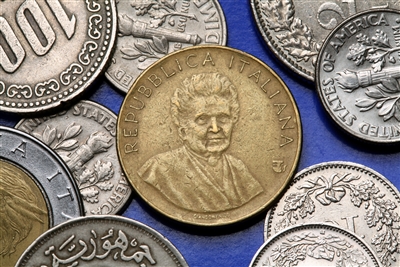Maria Montessori - the radical and pioneering teacher

Many will have heard of the Montessori Method of Education, which encourages hands on learning and directed play, but few people probably know much about the woman who founded this radical form of pedagogy.
Maria Montessori was born in 1870 in Chiaravalle, Italy. Her father was an Official of the Ministry of Finance, a rather grandiose title perhaps, given that he worked in the local state-operated tobacco factory. Her mother, Renilde Stoppani, who was an extremely well educated woman for the time, worked as a primary school teacher, and was the great niece of the famous Italian geologist and palaeontologist Antonio Stoppani.
Maria was a good all round student, but excelled in the sciences and mathematics. Upon graduation, gaining a high certificate in physics and maths, she intended to study medicine. Her initial application was refused however, back then medical school being solely the domain of men. Undeterred by this prejudice Maria left the interview saying
`I know I shall become a doctor.`
Two years later, having attained qualifications in botany, zoology, chemistry and physics, she began studying medicine at the university of Rome. Because of her gender she met with much hostility, from both teachers and students, who considered her attendance in classes, which often included studies of the naked body, to be inappropriate. Despite much hardship Maria was awarded an academic prize after completing her first year, and was even offered a job as a hospital assistant, a position that provided her with much useful early clinical experience. She still met with
opposition from her colleagues and teachers however, and she was barred form certain classes, and was obliged to perform her dissection of cadavers along, late at night. One can only wonder what went through her heard as she performed these tasks in the nocturnal gloom of the dissecting room, ostracised by the living, with only the dead for company.
During her final two years at the university Maria studied paediatrics and psychiatry, excelling in paediatric medicine. After three years of work she graduated as a doctor of medicine, becoming one of the very first female doctors in the whole of Italy.
Just a few months after she graduated she was asked to represent Italy at the international congress for women in Berlin. It was at this very congress that she delivered one of her historic speeches, arguing strongly and persuasively that women should receive equal pay to men. A reporter who was covering the event asked how her patients responded to being treated by a female doctor, to which Maria replied:
`they know intuitively when someone really cares about them It is only the upper classes that have a prejudice against women leading a useful existence.`
The next decade saw the flourishing of Maria`s work in paediatrics. One of her early roles was working as a surgical assistant at the Santo Spirito Hospital in Rome, the majority of her medicinal care being dispensed to poor, and especially their children. She soon became noted for her compassionate attitude, always ensuring patients were warm, well fed, and in as much comfort as ; the hospital and its staff could provide.
Another role was working for the numerous asylums for children with mental disorders, a task that revealed to her the full depravity and destitution thousands of poor children were living in. She soon became aware how desperately in need of mental stimulation these neglected children were, and she began an assiduous study on the pedagogical methods to help them.
Her in depth reading on this subject led her to discover the work of Jean-Marc Itard, and his student Edouard Seguin, who had produced groundbreaking theories of learning after working with the `wild boy of Aveyron,` a `feral` child who grew up alone in the woods, and was subject to much study by enlightenment sociologists and doctors.
By 1897 Maria`s work with children at the asylums had begun to receive notice in academic circles, and she was requested to make an address at the National Medical Congress in Turin. In her speech she she expounded the controversial theory that it was the neglect of children with emotional and mental disorders that both led to, and exacerbated their conditions.
Over the next 50 years Maria would go on to develop her method of education, one that would be applicable to children of all abilities and dispositions. Features of her pedagogy included such simple and practical things as limiting heavy and bulky furniture in classrooms, and using where possible equipment that is congenial to the smaller stature of children, and easier for them to manipulate. The strikingly obvious idea of having chairs that are light enough for children to move is an example of this, along with ensuring children`s textbooks, and writing paraphernalia are placed on low accessible shelves.
She also stressed the idea of seeing all children as individuals, treating each of them in such a way that respects their varied temperaments and learning abilities. Another key feature of her technique was encouraging children to learn autonomously, and she often said that the clearest sign she was teaching well was that `the children are now working as if I did not exist.`

 Add a Comment
Add a Comment